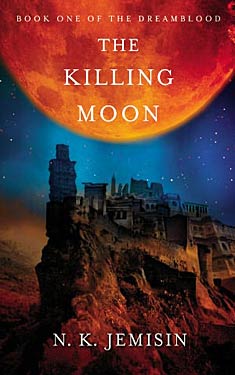NK Jemisin
Completed 6/10/2020,
Reviewed 6/10/2020
4 stars
This first
book of the Dreamblood Duology marks the third series by NK Jemisin I’ve
read. She is an awesome world
builder. This time, the world consists
of a people who harvest dreams to use for healing and the maintenance of peace.
In addition, the final dream harvest,
done by Gatherers, guides a person’s soul to the afterlife and union with the Goddess
of Dreams. It is akin to euthanasia and
it is a peaceful way to die. However,
there are other tribes around this one that find the practice appalling. This conflict makes for an amazingly dark
fantasy filled with action and intrigue.
Ehiru is a Gatherer. He is given a commission to do such a harvest and botches it up. Instead of peaceful death, the recipient has a horrifying death. He goes into seclusion to repent for his terrible error. Later he is accused of being a Reaper, a rogue Gatherer who simply murders people to feed on their dreams. He is given a chance to clear his name by taking a new commission, to do a final extraction on Sunandi, an ambassador for a neighboring nation which abhors dream harvesting. When her servant tries to stop Ehiru, she awakens, and tries to convince him that the Reaper is part of a larger plot to incite war with her nation. She mostly convinces him. Together with his apprentice Gatherer, Nijiri, the three try to figure out the plot and the mystery of the Reaper.
Ehiru is a Gatherer. He is given a commission to do such a harvest and botches it up. Instead of peaceful death, the recipient has a horrifying death. He goes into seclusion to repent for his terrible error. Later he is accused of being a Reaper, a rogue Gatherer who simply murders people to feed on their dreams. He is given a chance to clear his name by taking a new commission, to do a final extraction on Sunandi, an ambassador for a neighboring nation which abhors dream harvesting. When her servant tries to stop Ehiru, she awakens, and tries to convince him that the Reaper is part of a larger plot to incite war with her nation. She mostly convinces him. Together with his apprentice Gatherer, Nijiri, the three try to figure out the plot and the mystery of the Reaper.
Ehiru,
Nijiri, and Sunandi are all very well developed. It was easy to get into all their heads. The book is narrated mostly through them in
third person. I liked all three, despite
their different moralities. They all
remain true to themselves and yet find a common interest to fight for, the
maintenance of peace. The secondary
characters are also surprisingly three dimensional. Even the bad guy is done well. I didn’t even realize he’s the bad guy until
later in the book.
The world
building is interesting because it is roughly based on ancient Egypt. The heart of the main city-state is at the delta
of a river very much like the Nile. It
floods its banks every year and fertilizes the soil. People count floods, not years. It is surrounded by a desert which is sparsely
populated. It is the most prosperous
state and its primary law is peace. It
is ruled by a Prince in a line that’s supposedly descended from the sun. It has a Pantheon, but only a few of the gods
are reference in this book. The most
notable and revered is the Goddess of Dreams and the Afterlife.
Jemisin’s
writing is always incredibly readable.
She has great balance between prosy descriptions and dialogue. Her ideas are very original, and she does a
great job of explaining them over the course of the book. It does help that she includes a glossary of
terms.
The one
thing I didn’t care for about the book was that it was a slow burn. Things happen, but it took a while for it to all
come together. It’s engrossing,
especially in the middle and at the end, but beginning dragged a bit. I think it was because there were so many concepts
introduced, it was hard for me to take it all in. There was also the problem of three main
characters to introduce. They all get
their own chapter in the beginning, but they do so with a lot of the secondary
characters as well. Again, it was a sort
of overload.
Overall, it’s
really a terrific book. I give it four
stars out of five. It’s dark and very serious. It’s original and creative. I’m continually amazed at Jemisin’s
imagination. She designs worlds,
complete with mythologies and magics, that are very different from each other. It’s no wonder that her books are nominated
for awards and show up on best-of lists.

No comments:
Post a Comment